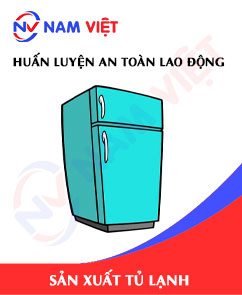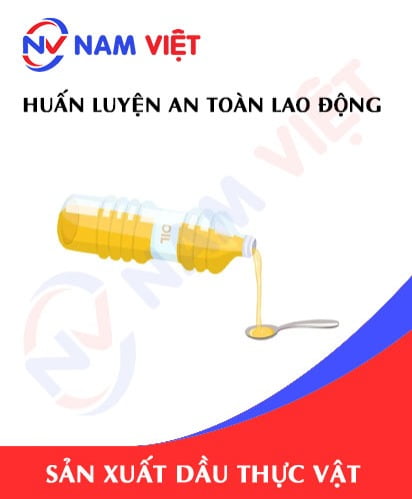Occupational Safety Training For Refrigerator Manufacturing
99,000 ₫
Note: The above price is calculated for one person, the price may fluctuate depending on the number of trainees participating in the course and the movement of the market. For more accurate pricing support, please refer to the quotation or contact directly with our consultants.
Occupational safety is an important issue in refrigerator manufacturing factories and needs to be addressed promptly to ensure the health and safety of workers, as well as to enhance the reputation of enterprises. The Occupational Safety Training course is one of the effective solutions to raise awareness about preventing occupational accidents for workers participating in refrigerator manufacturing.
Table of Contents
Toggle1. Overview of Refrigerators
a. What is a Refrigerator?
A refrigerator, also known as a freezer or cooling cabinet, is a household appliance used to preserve food by lowering the temperature below room temperature. Refrigerators are typically divided into two main types: top-freezer refrigerators (also called double-door refrigerators) and bottom-freezer refrigerators (also called freezer compartment refrigerators).
Refrigerators are commonly used in households, restaurants, grocery stores, and supermarkets to store fresh or frozen food.

b. Machinery for Refrigerator Manufacturing
A refrigerator manufacturing plant may use various types of machinery to produce refrigerators, from smaller components to the finished product. Common machinery used in refrigerator production includes:
- Sheet metal cutting machine: Used to cut steel sheets to precise sizes to form refrigerator parts.
- Sheet metal bending machine: Used to bend steel sheets into the desired shapes, such as corners for refrigerator molds.
- Sheet metal welding machine: Used to weld steel sheets into refrigerator components.
- Metal pressing machine: Used to press metal parts together to form a sturdy frame.
- Plastic injection molding machine: Used to mold plastic parts for the refrigerator, such as vegetable trays, fruit compartments, and air deflectors.
- Insulation foam spraying machine: Used to spray insulating foam into the refrigerator to maintain internal temperature.
- Circuit board pressing machine: Used to press the electronic circuit boards for the refrigerator.
- Glass processing machine: Used to cut and process glass for refrigerator doors.
These are just some of the main machines used in refrigerator production. Specific equipment may vary depending on the factory and refrigerator type.

c. Refrigerator Manufacturers in Vietnam
There are many well-known refrigerator brands worldwide from different countries. Some famous brands include:
- Samsung (South Korea)
- LG (South Korea)
- Panasonic (Japan)
- Whirlpool (United States)
- Electrolux (Sweden)
- Haier (China)
- Siemens (Germany)
- Bosch (Germany)
- Sharp (Japan)
- Toshiba (Japan)
In Vietnam, besides the international brands, there are also some domestic refrigerator brands, such as:
- Sanaky
- Alaska
- Aqua
- Electrolux (Vietnam)
- Kangaroo
- Sanyo (Vietnam)
- Toshiba (Vietnam)

d. Specific Jobs in a Refrigerator Manufacturing Plant
Group 1
- Executive director, deputy director, department heads in a refrigerator manufacturing plant.
Group 2
- Safety officers: manage safety in the factory, design safety procedures, monitor and enforce employee compliance with safe work procedures.
Group 3
- Frame assembly: Workers assemble the refrigerator frame using steel or aluminum components, then weld them together and check for strength and durability.
- Component installation: Components such as compressors, fans, gas pipes, motors, sensors, and controllers are installed using specialized tools and equipment.
- Quality inspection: Refrigerators are inspected to ensure they function efficiently, are quiet, and energy-efficient.
- Electrical and electronic assembly and testing: Electronic and electrical parts are installed and tested, including controllers, temperature sensors, voltage converters, and compressors.
- Product inspection and packaging: Refrigerators are re-inspected before packaging to ensure quality and compliance with safety regulations.
- Transportation and installation: After production and packaging, refrigerators are delivered to dealers or stores for sale or installed directly at customers’ homes.
- Maintenance and repair: Factory workers also perform maintenance and repair tasks to ensure refrigerators operate safely and efficiently.
Group 4
- Office work, services, sales, marketing.
- Production management, quality management, human resources, material management, finance and accounting management.
- Research and development of new products, designing product packaging.

2. Overview of Occupational Safety Training for Refrigerator Manufacturing
This article focuses on issues related to Group 3, because Group 3 directly participates in the manufacturing process and faces the highest occupational safety risks. For more information on other groups, see here.
a. What is Group 3 Occupational Safety Training?
- Group 3 occupational safety training consists of sessions that provide workers with awareness and skills to prevent workplace accidents.
- The training helps workers identify and avoid hazards, reducing the risk of accidents during work.
REGISTER FOR OCCUPATIONAL SAFETY TRAINING SERVICE
b. Training Duration
Initial Safety Training Duration
- Total training duration is at least 24 hours, including testing time.
- 8 hours of theory on policies, laws regarding occupational safety and hygiene
- 8 hours of theory on basic occupational safety and hygiene knowledge
- 4 hours of theory on specialized training content
- 2 hours of practical training on specialized content
- 2 hours of theory testing at the end of the course
The safety training center schedules sessions based on workers’ availability, typically consisting of 6 sessions over 3 days, provided the company can arrange continuous training time.
Periodic Safety Training Duration
- Before the occupational safety card expires, workers wishing to renew it must complete periodic occupational safety training, with periodic training duration being at least 50% of the initial training duration.
Explanation: Total periodic occupational safety training must be at least 12 hours, including testing. Upon completion and passing the test, workers will have their occupational safety card renewed.
c. Training Content
| No. | TRAINING CONTENT | TRAINING DURATION (HOURS) | |||
| Total | Including | ||||
| Theory | Practice | Test | |||
| I | Policies and laws on occupational safety and hygiene | 8 | 8 | 0 | 0 |
| 1 | Overview of legal documents regarding occupational safety and hygiene. | 6 | 6 | ||
| 2 | Standards and technical regulations on occupational safety and hygiene. | 1 | 1 | ||
| 3 | Specific regulations from state management agencies regarding occupational safety when constructing, expanding, or renovating production facilities, handling equipment, and managing hazardous materials. | 1 | 1 | ||
| II | Basic knowledge of occupational safety and hygiene | 8 | 8 | 0 | 0 |
| 1 | Basic knowledge of workplace hazards and harmful factors. | 4 | 4 | ||
| 2 | Methods to improve working conditions. | 1 | 1 | ||
| 3 | Safety culture in production and business. | 1 | 1 | ||
| 4 | Rights and obligations of employers and employees; policies and regulations on occupational safety for employees; roles of safety network and hygiene officers. | 1 | 1 | ||
| 5 | Rules on occupational safety, safety signs, instructions, use of safety equipment, personal protective equipment; first aid skills and occupational disease prevention. | 1 | 1 | ||
| III | Specialized training content | 6 | 4 | 2 | 0 |
| Comprehensive knowledge about machines, equipment, hazardous materials; risk analysis and management; safe work procedures for machines and hazardous materials. | 6 | 4 | 2 | ||
| IV | Final safety training test | 2 | 2 | 0 | 0 |
| Total | 24 | 22 | 2 | ||
See more training content of the 6 groups
d. Occupational Safety Card
After completing the occupational safety training and passing the test, workers will be issued an occupational safety card (commonly known as the Group 3 safety certificate).
The Group 3 safety card displays information such as full name, date of birth, job, and specific work environment. It also includes training duration, official stamp, and signature confirming course completion.
According to the issuance regulations in Clause 2 of Article 24, Decree 44/2016/ND-CP, there are two cases:
- If the employer and employee have a labor contract, the employer must sign, stamp, and endorse the Group 3 safety card after the worker completes training and passes the test.
- If the worker is freelance or seasonal without a labor contract, the training unit must sign, stamp, and endorse the safety card after the worker completes training and passes the test.

3. Identifying Hazards Affecting Workers in Refrigerator Manufacturing
Potential hazards in refrigerator manufacturing include:
- Electrical hazards: Refrigerators require a large power supply, which may cause electrical leakage, short circuits, or fire hazards.
- Toxic gas hazards: Manufacturing may generate toxic gases, especially ammonia and other harmful chemicals.
- Temperature hazards: Handling materials and motors during production can lead to high temperatures, posing health risks to workers.
- Noise hazards: Some manufacturing stages produce high noise levels, affecting workers’ hearing.
- Mechanical hazards: Using mechanical tools and machinery can cause accidents, injuries, or even fatalities.

4. Common Types of Occupational Accidents for Workers in Refrigerator Manufacturing
Common types of occupational accidents in the refrigerator manufacturing process include:
- Injury-related accidents: This is the main risk in refrigerator manufacturing factories, due to contact with cutting, grinding, chiseling, drilling, bending equipment, and components made of steel, glass, plastic, insulation materials, and other substances.
- Accidents due to chemical use: During refrigerator manufacturing, workers are exposed to many chemicals such as cleaners, adhesives, coatings, and other chemicals. Without proper personal protective equipment and correct usage, this can lead to accidents such as burns, allergies, skin irritation, rashes, and even cancer.
- Accidents caused by heavy objects: Transporting and handling refrigerator components can result in serious accidents, such as being struck by falling objects, falling to the ground, or being crushed during work.
- Electric shock accidents: Workers in refrigerator manufacturing factories are at risk of electric shock when working with electrical devices, such as controllers, motors, and transformers.
- Temperature-related accidents: During refrigerator manufacturing, workers must handle cooling devices and insulation materials, which may lead to accidents such as burns, skin irritation, breathing difficulties, dizziness, and lightheadedness.

5. Safety Measures When Participating in Refrigerator Manufacturing
Safety measures when participating in refrigerator manufacturing include:
- Wearing protective equipment: Workers should wear personal protective equipment such as helmets, safety glasses, gloves, and safety shoes to protect feet from impacts and injuries.
- Complying with safety regulations: Workers should follow safety regulations and instructions for using machinery and equipment to prevent accidents.
- Regularly inspecting and maintaining equipment: Manufacturing equipment should be regularly checked and maintained to ensure stable operation and reduce accident risks.
- Noise reduction: Noise in refrigerator manufacturing factories can harm workers’ hearing. Measures should be implemented to minimize noise in the workplace.
- Managing materials and chemicals: Materials and chemicals must be tightly managed and safely handled to prevent fire, explosion, and toxicity risks.
- Occupational safety training: Factories should provide full training for workers on safety regulations, equipment use, and emergency responses to minimize accident risks.
- Periodically organizing occupational environment monitoring in factories, collecting and analyzing harmful factors affecting workers, and adjusting to reduce hazards to prevent occupational diseases.
6. Benefits of Occupational Safety Training in Refrigerator Manufacturing
An Toan Nam Viet provides your business with excellent benefits after completing occupational safety training courses as prescribed in Decree 44/2016/ND – CP on occupational safety and hygiene work, applicable to companies, enterprises, and businesses.
- Workers can recognize potential occupational accident risks and take preventive measures to avoid accidents.
- Your business can establish risk prevention measures in production, operation, and maintenance processes.
- Reduce costs associated with occupational safety risks.
- Uninterrupted production helps increase labor productivity and product quality.
- Comply with occupational safety laws, avoiding legal risks.
- Create credibility and professionalism, thereby enhancing your business brand.
Nam Viet’s training courses provide solutions to prevent external factors from affecting individuals, allowing them to avoid dangers that could lead to injury or even death.
REGISTER FOR OCCUPATIONAL SAFETY TRAINING SERVICE
7. Customer Feedback After Completing Occupational Safety Training in Refrigerator Manufacturing
An Toan Nam Viet has many years of experience accompanying businesses in Vietnam in general and southern provinces in particular. This responsibility is extremely valuable, so our occupational safety training work is increasingly professional. The motivation for An Toan Nam Viet to grow comes from both positive feedback and suggestions from businesses. Below are feedbacks from partners we have served.
Hoa Dat Construction And Trading Joint Stock Company
“Nam Viet’s service helped us greatly in simplifying occupational safety and completing safety documentation. The consulting team is enthusiastic and timely in answering our questions. 5 stars for Nam Viet.”
See more customer interview sessions after using the service of An Toan Nam Viet
8. Occupational Safety Training Capacity of An Toan Nam Viet
An Toan Nam Viet is a reputable and high-quality occupational safety training center in Vietnam today, with training sessions held continuously at workshops, factories, and construction sites across all 63 provinces.
REGISTER FOR OCCUPATIONAL SAFETY TRAINING SERVICE
License for occupational safety training
- An Toan Nam Viet has been inspected and granted a certificate of eligibility for occupational safety and hygiene training by the Occupational Safety Department of the Ministry of Labor – Invalids and Social Affairs. This strengthens our occupational safety training capacity.

Documents and lectures
- Before use in occupational safety training courses, materials are reviewed to ensure accuracy and practical effectiveness.
- Lecturers’ teaching methods follow An Toan Nam Viet standards, researched by experts in occupational safety and hygiene training to maximize knowledge absorption.
Facilities
- Controlling classroom factors affecting training increases teaching efficiency and knowledge retention.
- Training-support facilities always provide spacious classrooms meeting standards for area, lighting, and equipment.
9. Prestigious Nationwide Occupational Safety Training Center
At An Toan Nam Viet, professional dedication to occupational safety training is the top priority. Teaching workers to protect themselves contributes to building the country.
To ensure effective training, we meticulously prepare every detail, from tools, teaching equipment, curriculum, materials, sound, and lighting.
Our occupational safety lecturers are experts with years of experience, including research on identifying hazards in all professions and prevention methods.
Lectures are drawn from practice and presented vividly to workers, facilitating comfortable learning and effective knowledge absorption. Knowledge is always aligned with Decree 44/2016/ND-CP.
Workers learn many hazard prevention measures and how to protect themselves, applying them appropriately in actual work.
Our safety training center proudly provides reputable, professional occupational safety training services with the following advantages:
- Competitive training costs while ensuring quality.
- Flexible training schedules suitable for company production.
- Quick and legally compliant certification procedures.
- Lecturers with extensive professional experience.
- Classrooms optimized for training efficiency and knowledge retention.
- Curriculum tailored to enterprise occupational safety work.
- An Toan Nam Viet works dedicatedly and professionally to support clients accurately and promptly.

10. Additional References for Occupational Safety Training in Refrigerator Manufacturing
- Occupational safety training document set
- Occupational safety documents in refrigerator manufacturing
- Occupational safety training test set
- Refrigerator manufacturing occupational safety training curriculum
- Multiple-choice test on occupational safety in refrigerator manufacturing
1 review for Occupational Safety Training For Refrigerator Manufacturing
No comments yet















namchinh.haiphong341
Dịch vụ huấn luyện an toàn lao động rất tốt nhé, giảng viên dạy rất sinh động dễ hiểu!